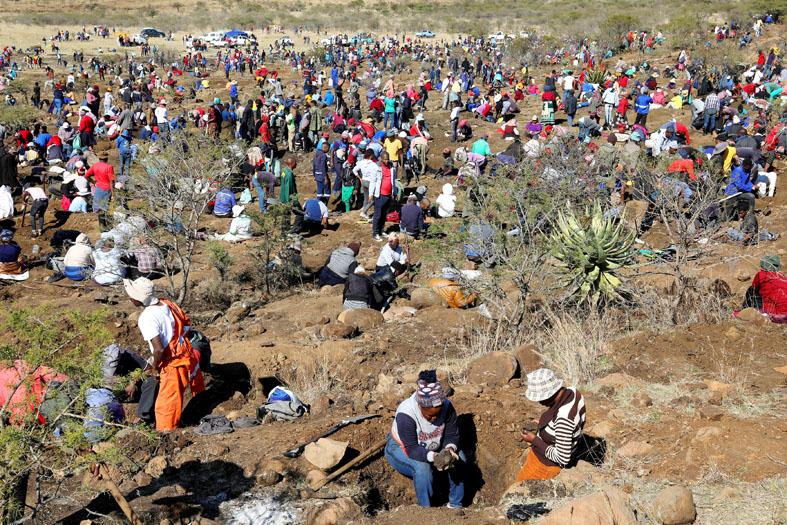Gemstones that sparked a diamond rush to eastern South Africa last week have turned out to be just quartz, according to preliminary findings presented on Sunday.
Thousands of people flocked to a hillside in South Africa’s KwaZulu-Natal Province to dig for mysterious stones first unearthed by a cattle herder and believed to be diamonds.
The rush prompted the South African government to send geoscientists and mining experts to collect samples for testing.

Photo: Reuters
The results quashed the dreams of diggers hoping to come up with a fortune.
“The tests conducted conclusively revealed that the stones discovered in the area are not diamonds,” a local government statement said.
“In fact, what has been discovered are quartz crystals,” it said, adding that the yet-to-determined value of the stones would be “very low” compared with diamonds.
The report said the site — more than 300km southeast of Johannesburg — was near a sill of volcanic rock called dolerite, “which is not in a zone where diamond occurrences are present.”
It added that quartz crystals were common across a sedimentary basin known as the Karoo Supergroup, which stretches over the site, and particularly abundant along the dolerite sill.
The prospect of finding a diamond had sent ripples of hope across one of South Africa’s poorest regions and beyond.
The nation, renowned for its mineral wealth, has struggled with decades of spiraling unemployment worsened by the COVID-19 pandemic.
The diamond rush “highlighted the socioeconomic challenges confronting people in the area,” the statement said.
The South African government reiterated its call for people to vacate the area, citing COVID-19 risks and environmental degradation.

The death of a former head of China’s one-child policy has been met not by tributes, but by castigation of the abandoned policy on social media this week. State media praised Peng Peiyun (彭珮雲), former head of China’s National Family Planning Commission from 1988 to 1998, as “an outstanding leader” in her work related to women and children. The reaction on Chinese social media to Peng’s death in Beijing on Sunday, just shy of her 96th birthday, was less positive. “Those children who were lost, naked, are waiting for you over there” in the afterlife, one person posted on China’s Sina Weibo platform. China’s

‘NO COUNTRY BUMPKIN’: The judge rejected arguments that former prime minister Najib Razak was an unwitting victim, saying Najib took steps to protect his position Imprisoned former Malaysian prime minister Najib Razak was yesterday convicted, following a corruption trial tied to multibillion-dollar looting of the 1Malaysia Development Berhad (1MDB) state investment fund. The nation’s high court found Najib, 72, guilty on four counts of abuse of power and 21 charges of money laundering related to more than US$700 million channeled into his personal bank accounts from the 1MDB fund. Najib denied any wrongdoing, and maintained the funds were a political donation from Saudi Arabia and that he had been misled by rogue financiers led by businessman Low Taek Jho. Low, thought to be the scandal’s mastermind, remains

‘POLITICAL LOYALTY’: The move breaks with decades of precedent among US administrations, which have tended to leave career ambassadors in their posts US President Donald Trump’s administration has ordered dozens of US ambassadors to step down, people familiar with the matter said, a precedent-breaking recall that would leave embassies abroad without US Senate-confirmed leadership. The envoys, career diplomats who were almost all named to their jobs under former US president Joe Biden, were told over the phone in the past few days they needed to depart in the next few weeks, the people said. They would not be fired, but finding new roles would be a challenge given that many are far along in their careers and opportunities for senior diplomats can

Australian Prime Minister Anthony Albanese yesterday announced plans for a national bravery award to recognize civilians and first responders who confronted “the worst of evil” during an anti-Semitic terror attack that left 15 dead and has cast a heavy shadow over the nation’s holiday season. Albanese said he plans to establish a special honors system for those who placed themselves in harm’s way to help during the attack on a beachside Hanukkah celebration, like Ahmed al-Ahmed, a Syrian-Australian Muslim who disarmed one of the assailants before being wounded himself. Sajid Akram, who was killed by police during the Dec. 14 attack, and